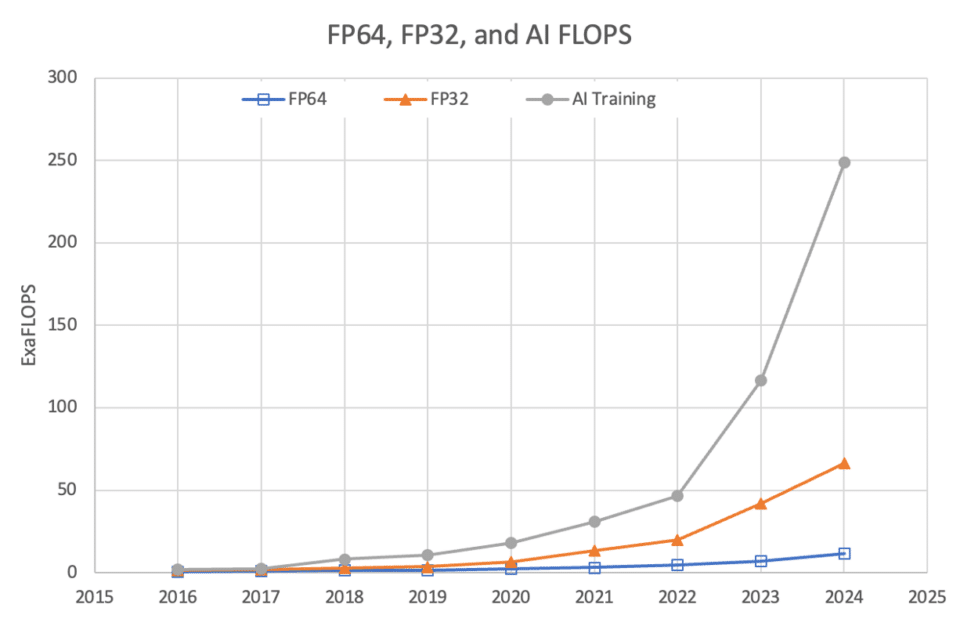Starting with the release of CUDA in 2006, NVIDIA has driven advancements in AI and accelerated computing — and the most recent TOP500 list of the world’s most powerful supercomputers highlights the culmination of the company’s achievements in the field.
This year, 384 systems on the TOP500 list are powered by NVIDIA technologies. Among the 53 new to the list, 87% — 46 systems — are accelerated. Of those accelerated systems, 85% use NVIDIA Hopper GPUs, driving advancements in areas like climate forecasting, drug discovery and quantum simulation.
Accelerated computing is much more than floating point operations per second (FLOPS). It requires full-stack, application-specific optimization. At SC24 this week, NVIDIA announced the release of cuPyNumeric, an NVIDIA CUDA-X library that enables over 5 million developers to seamlessly scale to powerful computing clusters without modifying their Python code.
NVIDIA also revealed significant updates to the NVIDIA CUDA-Q development platform, which empowers quantum researchers to simulate quantum devices at a scale previously thought computationally impossible.
And, NVIDIA received nearly a dozen HPCwire Readers’ and Editors’ Choice awards across a variety of categories, marking its 20th consecutive year of recognition.
A New Era of Scientific Discovery With Mixed Precision and AI
Mixed-precision floating-point operations and AI have become the tools of choice for researchers grappling with the complexities of modern science. They offer greater speed, efficiency and adaptability than traditional methods, without compromising accuracy.
This shift isn’t just theoretical — it’s already happening. At SC24, two Gordon Bell finalist projects revealed how using AI and mixed precision helped advance genomics and protein design.
In his paper titled “Using Mixed Precision for Genomics,” David Keyes, a professor at King Abdullah University of Science and Technology, used 0.8 exaflops of mixed precision to explore relationships between genomes and their generalized genotypes, and then to the prevalence of diseases to which they are subject.
Similarly, Arvind Ramanathan, a computational biologist from the Argonne National Laboratory, harnessed 3 exaflops of AI performance on the NVIDIA Grace Hopper-powered Alps system to speed up protein design.
To further advance AI-driven drug discovery and the development of lifesaving therapies, researchers can use NVIDIA BioNeMo, powerful tools designed specifically for pharmaceutical applications. Now in open source, the BioNeMo Framework can accelerate AI model creation, customization and deployment for drug discovery and molecular design.
Across the TOP500, the widespread use of AI and mixed-precision floating-point operations reflects a global shift in computing priorities. A total of 249 exaflops of AI performance are now available to TOP500 systems, supercharging innovations and discoveries across industries.

NVIDIA-accelerated TOP500 systems excel across key metrics like AI and mix-precision system performance. With over 190 exaflops of AI performance and 17 exaflops of single-precision (FP32), NVIDIA’s accelerated computing platform is the new engine of scientific computing. NVIDIA also delivers 4 exaflops of double-precision (FP64) performance for certain scientific calculations that still require it.
Accelerated Computing Is Sustainable Computing
As the demand for computational capacity grows, so does the need for sustainability.
In the Green500 list of the world’s most energy-efficient supercomputers, systems with NVIDIA accelerated computing rank among eight of the top 10. The JEDI system at EuroHPC/FZJ, for example, achieves a staggering 72.7 gigaflops per watt, setting a benchmark for what’s possible when performance and sustainability align.
For climate forecasting, NVIDIA announced at SC24 two new NVIDIA NIM microservices for NVIDIA Earth-2, a digital twin platform for simulating and visualizing weather and climate conditions. The CorrDiff NIM and FourCastNet NIM microservices can accelerate climate change modeling and simulation results by up to 500x.
In a world increasingly conscious of its environmental footprint, NVIDIA’s innovations in accelerated computing balance high performance with energy efficiency to help realize a brighter, more sustainable future.
Supercomputing Community Embraces NVIDIA
The 11 HPCwire Readers’ Choice and Editors’ Choice awards NVIDIA received represent the work of the entire scientific community of engineers, developers, researchers, partners, customers and more.
The awards include:
- Readers’ Choice: Best AI Product or Technology – NVIDIA GH200 Grace Hopper Superchip
- Readers’ Choice: Best HPC Interconnect Product or Technology – NVIDIA Quantum-X800
- Readers’ Choice: Best HPC Server Product or Technology – NVIDIA Grace CPU Superchip
- Readers’ Choice: Top 5 New Products or Technologies to Watch – NVIDIA Quantum-X800
- Readers’ Choice: Top 5 New Products or Technologies to Watch – NVIDIA Spectrum-X
- Readers’ and Editors’ Choice: Top 5 New Products or Technologies to Watch – NVIDIA Blackwell GPU
- Editors’ Choice: Top 5 New Products or Technologies to Watch – NVIDIA CUDA-Q
- Readers’ Choice: Top 5 Vendors to Watch – NVIDIA
- Readers’ Choice: Best HPC Response to Societal Plight – NVIDIA Earth-2
- Editors’ Choice: Best Use of HPC in Energy (one of two named contributors) – Real-time simulation of CO2 plume migration in carbon capture and storage
- Readers’ Choice Award: Best HPC Collaboration (one of 11 named contributors) – National Artificial Intelligence Research Resource Pilot
Watch the replay of NVIDIA’s special address at SC24 and learn more about the company’s news in the SC24 online press kit.
See notice regarding software product information.